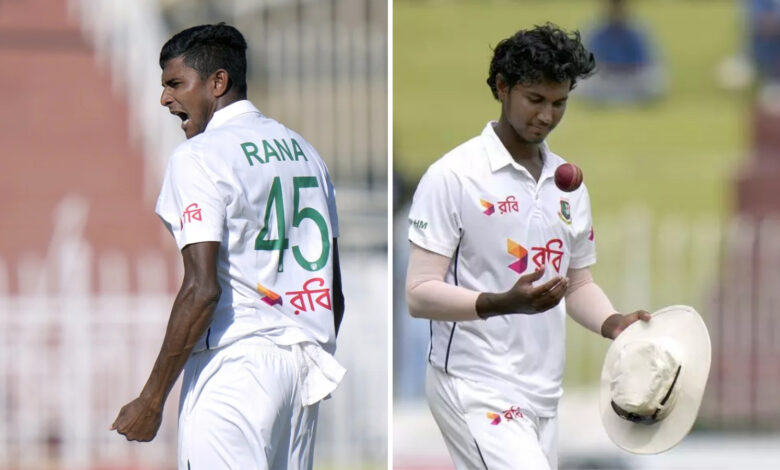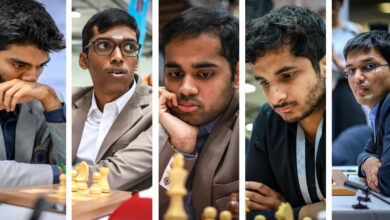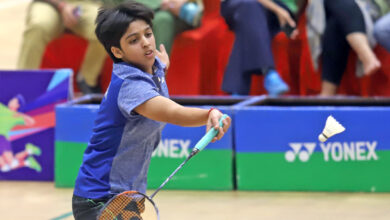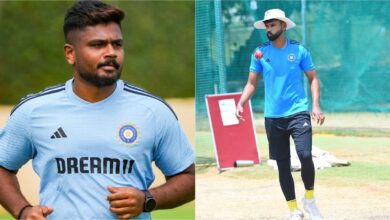India Test series provides pathbreaking moment for Bangladesh: The first 150-kph-er in Nahid Rana and Hasan Mahmud, with unique action, raise fast-bowling hopes | Cricket News

A speed merchant nudging 150kph, a sui generis in his country; a seam and swing merchant with dexterous wrs and a natural gift of bending the ball either ways; a beanpole left-arm quick coaxing unnerving lift and slippery pace; an exciting but erratic talisman discovering precision to ally his pace; a stream of young quicks brling about in the domestic circuit. In unison, they are re-imaging the cricket identity of their country, from a land of left-arm spinners to fast bowlers. For much of their exence in international cricket, left-arm finger spinners formed the breathing soul of Bangladesh. The first famous cricketer from the pre-independent era was a left-arm spinner with handlebar moustache, Ramchand Goala; its first cult hero, Mohammed Rafique, practised left-arm spin too; its first superstar cricketer, Shakib Al Hasan, was inevitably a left-armer too. Left-arm spinners have accounted for 39 percent of Bangladesh’s wickets in Test cricket. The in-house banter used to be that if someone flipped a coin in the anarchic streets of Dhaka, a left-arm spinner would catch it. But the new crop of fast bowlers is shifting stubborn perceptions.
For the first time in their hory, seamers took all ten wickets in an innings, en route to winning the first Test against Pakan. The first time they won a Test, in Harare, left-armers hoarded 11 of the 20 wickets. But Test wins arrived only sporadically until the stroke of 2023 (16 in 134). In the next 20 months though, they won five of eight. It is little coincidence that those— one fourth of their Test wins ever—have arrived after they built a serious pace pack. Left-arm spinners still influence games, but so do the seamers. Ebadot Hossain and Taskin Ahmed starred in the victory over Afghanan, Hasan Mahmud and Nahid Rana headlined the horic feat over Pakan.
The surge of Rana could be a prospectively pathbreaking moment for Bangladesh fast bowling. He is his country’s first 150-kph-er. Until four years ago, the quick from the regally sounding Chapainawabganj in north western part of Bangladesh had no serious aspirations about the game. His father wanted him to focus on academics, but he snuck out with friends to play tape-ball cricket.
Impressed Nahid Rana @BCBtigers. He has a good technical action. Semi front on bowler with a large arm pull and shoulder hip separation. Terrific base alignment. On release he could be better in alignment with bowling arm and head but one of the better actions out there. And… pic.twitter.com/Bh8rvZ3Zkp
— Ian Pont Official (@Ponty100mph) September 12, 2024
During one of the tournaments, he caught the eye of former Test fast bowler Alamgir Kabir, a coach at the Clemon Academy, a chain of cricket schools launched former captain Khaled Mashud. “We were playing tape ball cricket and we needed a fast bowler. A local coach sent us Nahid. The keeper said he could barely see the first four ball. I kept for a ball and I couldn’t see it either,” Kabir tells The Indian Express.
The surge of Rana could be a prospectively pathbreaking moment for Bangladesh fast bowling. He is his country’s first 150-kph-er. (AP)
The latter took him under his tutelage at the Rajshahi branch of the academy. He was uncut, had a weird action wherein he held the ball with both palms. Alamgir refined and regimented it, initially dropping pace before gaining it. Talha Subair, another fast bowler turned coach, solved his no-ball woes. Four years after the fateful tape-ball game, he co-instigated Bangladesh’s maiden series win over Pakan. In the mecca of the mystique paceman, on the red earth that chiselled Shoaib Akhtar, he troubled the finest of Pakan batsmen in Rawalpindi.
Twice he devoured Babar Azam, harassing him for pace generated from his shoulders and upper body. In the first innings of the second Test, he softened him up with short balls, before sliding the fuller one, which back-foot tied Babar drove, only to slash the ball back onto the stumps. In the first essay of the second innings, he grabbed him with a good-length bouncing ball that held the line after landing, grazing the edge.
Those are balls that leave an impression on batsmen, where you are not coaxed into indiscretion, but you couldn’t configure the delivery’s sting. He left Mohammed Rizwan with physical scars too. His career is nascent still, there is guarded optimism that he could be his country’s finest.
BCB director and a mentor to most cricketers from his country, Nazmul Abedeen Fahim buzzes with excitement. “To see a bowler from Bangladesh bowl 150 clicks is indeed exciting. Back in the day, we had just one medium pacer and the rest were all spinners. We have a good fast bowling stock, different types of them, we have diversity in the spin department. Such an attack is required to win Tests on a consent basis abroad. All the great sides had great fast bowlers,” he explains.
If Nahid discomfits with raw pace, Hasan Mahmud tricks batsmen with movement either direction at lively pace. Monikered the Laxmipur Express, he runs through his action with a negligible jump during the load-up, rather a long stride, like some of the Caribbean quicks of the 90s. He has a sumptuous wr position, which he worked extensively with former national coach Sarwar Imran.
“He has a unique action that confuses batsmen. Besides, he has variations that he smartly employs, apart from swing and pace” Sarwar says. Shakib Al Hasan dwelled on his wits: “Though he is young he has got a very good brain and has a good game sense, he can read the game well.” The former fast bowling coach Otis Gibson says he “could be an enormously important cricketer for his country.”
nahid rana bowled babar pic.twitter.com/BdS29Uda6Q
— zuann (@_zuann_) August 25, 2024
His entry was dramatic. Called to bowl in the nets, he troubled the whole lot, from Shakib Al Hasan and Mushfiqur Rahim to Litton Das and Najmul Hossain Shanto.
Complementing them is the six foot three Shoriful Islam, another bowler sculpted the hands of Alamgir, hailing from the northernmost outpost of Bangladesh, at Nogordanga in the Panchagarh village. The son of a rickshaw puller, after unseasonal rain ravaged his farms, professional cricket was beyond his dreams.
“There were days when I survived on one meal a day, or a fruit. There was no electricity in our home. So, to watch cricket I used to walk or cycle to a village some two kilometres away from home,” he told Daily Star. Playing cricket and volleyball was an escape from the everyday realities. A scout from Dinajpur centre of the Clemons Academy happened to spot him, from where Alamgir fast-tracked him to Rajshahi.
Auguring their depth are Ebadot Hossain and Khaled Ahmed. The latter is 30, perennially injury-prone but is lethal when fit and fresh. Ahmed is 31, but options don’t hurt in a county where fast bowlers have poppadom physiques.
For the first time in their hory, seamers took all ten wickets in an innings, en route to winning the first Test against Pakan. (AP)
Marshalling them is Taskin Ahmed. The perennially injured fast bowler might have featured in only 14 Tests, but when he burst through as a genuine quick a decade ago, he captured a generation of youngsters. “I think Taskin and Mashrafe Mortaza were important figures in capturing the imagination of the country more fertile to spinners. So more and more youngsters began to bowl fast,” says Fahim.
The spurt of fast bowlers is part coincidence and part design. “After 15-20 years in cricket, you start looking at what other countries are doing and you get inspired, you get role models. Pakan, and India in recent times, have produced good fast bowlers, and naturally we too got inspired,” he says.
The biggest factor, Fahim believes, is the robust coaching at grassroots. “We were blessed to have so many fast bowlers taking up coaching after retirement,” he says. Alamgir is a classic example—he mustered just three wicketless Tests, but buried his disappointment committing his life to grooming young pacers. So are Talha Jubair and Rubel Hossein, a host of men lost in Bangladesh’s spin-fixated era. The fundamentals imparted, they passed through the battle-hardened hands of international coaches. At some juncture, they had all been coached one of Allan Donald or Gibson, or both.
After the conquest of Pakan, Donald instantly posted a picture of the Bangladesh quicks on his Facebook wall. He later told Daily Star about how he helped them eliminate the fear factor: “One of my biggest challenges was to get the fear factor out of the dressing room. What I mean fear factor is that guys are a little bit fearful of making makes.” An inferiority complex of sorts. But Donald, with whom the group still interacts, gradually convinced them to shed that fear.
The pace bloom comes with riders. Most of them are young and still raw. The bowlers from the region are notoriously injury-prone. The next stage of development is equally important, says Fahim. “Keeping them fit is important. If we nurture them, keep them injury free and continue the development trajectory, we could certainly be competitive,” he says. En route, they would burn perceptions and the coin joke.






